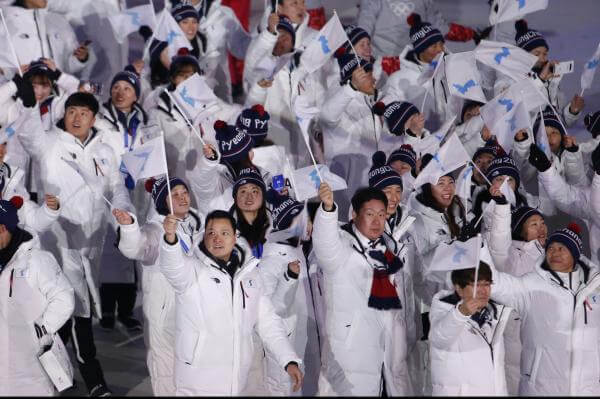This is an excerpt of the article by Michael Marshall that appeared on UPI on Feb. 12, 2018. See the full article here.

North and South Korean athletes walk together under one flag during the opening ceremony at the Pyeongchang 2018 Winter Olympics on Friday. Photo by Matt Healey/UPI
The participation of North Korean athletes in the Olympics, and the start of high-level talks between representatives of the North and South Korean governments, have raised hopes among many for a peaceful path forward. Almost everyone wants to avoid conflict. But we should not let the natural wish for peace blind us to the realities of what it will take to achieve it.
The Pyeongchang Games are leading Koreans to reflect on their past, on how far they have come, and the path they must navigate in the future to become one people once more.
North Korea today is a vestige of the Cold War, and a major source of instability in the region and world. Addressing these issues on the Korean Peninsula requires a clear vision for the endgame and a long-term strategy for getting there. Responding piecemeal to every threat or diplomatic overture from Kim Jong Un is not a coherent policy.
The Korean people have a common aspiration for one Korea — as expressed in the constitutions of both North and South. Unification of the Korean people, by peaceful means, must be the goal. The question is: What will be the nature of a unified Korea? What principles will govern it?
The answer may be found in a chapter of Korean history that preceded the current division. On March 1, 1919, while Korea was under Japanese colonial rule, the Sam-Il independence movement swept the peninsula, with peaceful rallies proclaiming the Korean Declaration of Independence, drawing some 2 million people.
The vision they affirmed was of a united, independent, and democratic nation. They drew upon the ancient Korean ideal of hongik ingan — living for the benefit of all humanity — as a guiding principle that had long inspired Korean development.
Their aspirations are yet to be fulfilled. The division of the peninsula at the end of WWII was intended as a temporary administrative measure. Despite resolutions of the newly established UN General Assembly calling for Korea to be “united, independent and democratic,” the free elections promised were never held, and in 1948 separate governments were established in the North and South.
The dream of a free and unified nation has been deferred for more than 100 years. Next year, 2019, is the centenary of the 1919 independence movement. This is an opportunity to honor the vision and courage of the independence pioneers and to recommit to the goals they hoped to achieve.
The Pyeongchang Olympics have provided the chance for dialogue between South and North, but real progress must involve not merely a unified Korea, but one that fulfills the long-held Korean dream —an independent and democratic Korea.
